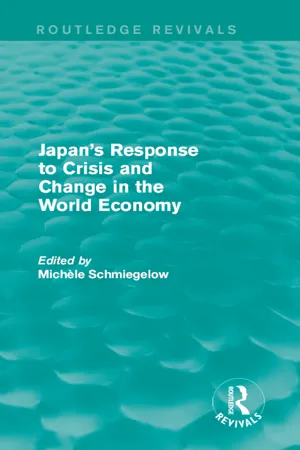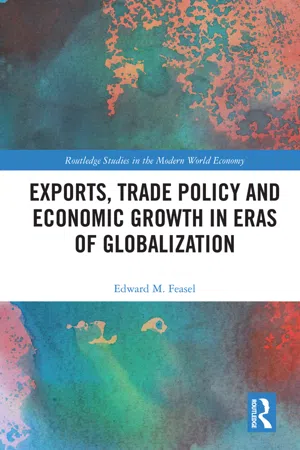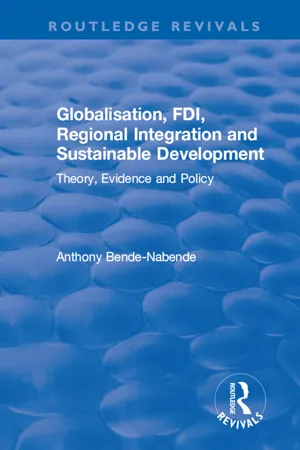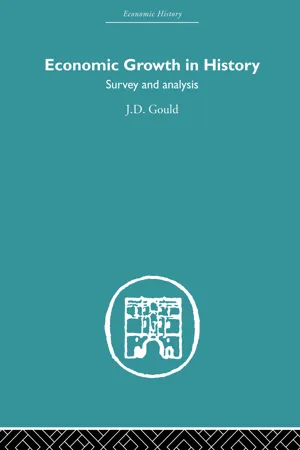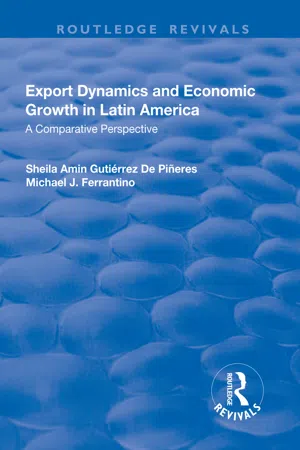Economics
Export Led Growth
Export-led growth refers to a strategy where a country focuses on increasing its exports as a means to drive economic growth. This approach typically involves producing goods and services for foreign markets, aiming to boost domestic production and employment. By expanding international trade, countries can potentially achieve higher levels of economic development and prosperity.
Written by Perlego with AI-assistance
Related key terms
Related key terms
1 of 4
Related key terms
1 of 3
6 Key excerpts on "Export Led Growth"
- Michèle Schmiegelow(Author)
- 2018(Publication Date)
- Routledge(Publisher)
10 EXTERNALIZATION OF DOMESTIC MACROECONOMIC PERFORMANCE: EXPORT-LED GROWTH OR GROWTH-LED EXPORT? Kazuo Sato IntroductionAs the economy of Japan has continued to grow since the early 1950s, so have Japan’s exports. Consisting almost wholly of manufactured goods, Japan’s share in the world’s manufactured trade has been steadily rising. By 1983, it finally surpassed that of the United States and edged next to West Germany, thus taking the number two position for the first time.For its leading exporting industries such as consumer electronics, steel, and automobiles, which have by and large been responsible for Japan’s export expansion, one may argue that the dominant position they achieved in the world market is essentially due to Japan’s domestic economic growth, which enabled them to improve productivity and to reach maturity on the strength of its expanding domestic base. In other words, domestic growth came first and exports followed suit. This is the thesis of growth-led export.1But, for Japan’s experiences in the period of decelerated growth following the first oil shock of 1973-74, there may be a counter-argument to the effect that Japan has relied heavily on its strong “export drive” in order to sustain its domestic growth, albeit at a much more reduced rate but still better than other nations. In other words, Japan succeeded in keeping up its growth by exporting its unemployment abroad. This is the thesis of export-led growth.Can the growth-led-export thesis still stand up in the more recent economic conditions? Or is it replaced by the export-led-growth thesis? This is the question that this chapter will consider at the macroeconomic level.Japan’s Macroeconomic Performance in the Decelerated Growth PeriodThe most serious macroeconomic problem that has confronted the Japanese economy since the mid-1970s is how to balance its aggregate saving and investment.2During its rapid-growth period of 1960-1973, the Japanese economy achieved a stunning record. Its average growth rate of real GNP amounted to 10 percent per annum. The rapid economic growth required the nation to raise its capital formation proportion. Private gross fixed investment rose from 15 percent of GNP in 1953 to 27 percent in 1973 when the proportion peaked. During the same period, the government maintained a small surplus on its budget, amounting to 1 percent of GNP. The balance of payments also turned toward a favorable position, with its current-account surplus averaging about 1.2 percent of GNP from 1965 to 1973. This, however, accounted for only a small fraction of private capital formation. The major burden of financing fell on private saving, especially household saving, which increased steadily during this period–from about 11 percent of household disposable income in the mid-1950s to a high of 24 percent in 1974.- Edward M. Feasel(Author)
- 2018(Publication Date)
- Routledge(Publisher)
Chapter 7 attempts to examine the issue of which forces cause growth more closely. Before we turn to the data to examine export expansion and contribution measures across countries and across time, it will be useful to provide a brief summary of both the theoretical literature on trade and growth and the empirical literature on the relationship between trade openness and growth. The former will give some context to knowing the possibilities and limits on what light the demand side accounting exercise might shed on our understanding of the relationship between exports and growth in terms of causation and role. The empirical literature will give background on the current sentiment in economics on the size and importance of openness for actually explaining economic growth.Theoretical underpinnings of growth theory: any role for exports?
In the Solow growth model, economic growth is driven by the supply side of the economy, and technology was assumed to be exogenous. New growth theory complicated this by allowing all inputs in the growth process on the supply side to be endogenously determined. Another complication that new growth theory added was to introduce the potential for the demand side of the economy, namely through trade, to impact economic growth. Traditionally, the field of macroeconomics has separated itself into the analysis of the business cycle on the one hand, represented by changes in output over several quarters or a few years, from economic growth on the other hand, represented by the growth of output over longer periods of time such as decades. In the former case, the fundamental debate has been whether the short-run aggregate supply curve is vertical or upward-sloping, which essentially determines whether demand has any role in influencing the level of output in the economy. Traditional Keynesian models with sticky prices and/or wages justified the upward slope to the aggregate supply curve and in that context would agree an export shock would cause an outward shift of the aggregate demand curve and output to increase. The rational expectations revolution led by Robert Lucas brought serious reflection on the role of demand in understanding output fluctuations, even in the short run, and led to the conclusion that where aggregate demand did have real effects in the economy, it was only due to imperfect information on the part of producers. On both sides of the debate, however, there was no contention that demand would have any impact in the long run, or on economic growth.- eBook - ePub
Globalisation, FDI, Regional Integration and Sustainable Development
Theory, Evidence and Policy
- Anthony Bende-Nabende(Author)
- 2017(Publication Date)
- Routledge(Publisher)
5 FDI and Economic Growth: pro-globalisation views IntroductionEconomic growth is a process of change through time, which involves an interrelationship between economic, political and social factors. It can be envisaged as an almost uninterrupted increase year after year, in a country’s per capita output. Thus, economic growth remains an urgent global need. Unsurprisingly, the development priorities of developing countries include income growth, rising investments and exports, creating more and better employment opportunities, and benefiting from technical progress. No wonder, developing countries are placed under considerable pressure to upgrade their resources and capabilities if they are to achieve these objectives.Consequently, factors that have the potential to act as ‘engines’ of economic growth and hence, factors that may explain transition from an undeveloped economy to a developed economy have to be identified. Several factors have been hypothesised and empirically tested under several economic growth theories. These theories have evolved over time, beginning with the classical theory followed by the neo-classical theory and then the new or endogenous growth theory. However, the traditional factors that propel sustained economic growth have not changed over time. They include the generation and efficient allocation of the basic factors of production, capital and labour. In addition, they include the application of technology and the creation of skills and institutions traditionally otherwise referred to as technical progress. Instead, it is the global context for economic growth that has changed enormously over the past three decades. This change has affected not only the role of the engines of economic growth, but also the influence of government policies on the engines of economic growth. Technical progress can be achieved through several channels. For instance, it may be stimulated by investment that augments and improves the productivity of national physical resources. Alternatively, it can be driven by innovations, which not only improve the productivity of existing activities, but also create competitive advantages in new activities. Additionally, it can be promoted by development of labour skills, or investment in human skills. The most recent focus of accounting for economic growth embraces factors such as human resources development, which relate to the role of quality improvements in the labour-force of an economy, improvements that come about from better health, more education and greater access to training. It also comprises technological change, international trade and government policy. These factors not only determine how well each economy utilises its factor endowments, but also affect how flexibly and dynamically each country adjusts to changes in economic conditions. - eBook - ePub
- W. Charles Sawyer, Richard L. Sprinkle(Authors)
- 2020(Publication Date)
- Routledge(Publisher)
If executed properly, an export promotion development strategy has a number of advantages. More resources will flow into the comparative advantage sectors and away from comparative disadvantage sectors. Everything else equal, this would tend to increase the rate of economic growth. Faster economic growth increases the rate at which new jobs are created. This is particularly important for countries in the stage of economic development where the labor force is growing at a rapid rate. Also, for many developing countries initially manufacturing will be in labor-intensive industries that provide more employment for less skilled workers moving out of the agricultural sector. Second, the policy may give the country a better chance of creating a more favorable balance between exports and imports. A larger volume of exports allows the country to more comfortably import products that it has a comparative disadvantage in. The final word on this development strategy is that it works better than import substitution. The empirical evidence on this issue is at this point virtually overwhelming. Economies developing along the lines of comparative advantage grow faster than economies utilizing policies that tend to distort the structure of the economy.BOX 12.5ECONOMIC DEVELOPMENT IN EAST ASIA VERSUS LATIN AMERICAA common topic in the economic development literature has been the growth of a selected group of economies in East Asia relative to countries in Latin America. The former group of countries has been extremely successful at raising GDP per capita and the latter group of economies less so. To illustrate this, consider the data in Table 12.5 . On the left-hand side of the table are GDP growth rates for three recent periods for East Asia.TABLE 12.5Comparative output growth performance, selected countries and country groups, 1991–2018 World output growth, 1991–2018 (Annual percentage change) Country or area 1991–2000 a2001–2008 a2008 2009 2010 2011 2012 2013 2014 2015 2016 2017 2018 bWorld 2.8 3.5 1.9 −1.8 4.3 3.1 2.5 2.6 2.8 2.8 2.5 3.1 3.1 Developed countries 2.6 2.2 0.1 −3.6 2.6 1.5 1.1 1.2 1.9 2.3 1.7 2.3 2.1 of which: - eBook - ePub
Economic Growth in History
Survey and Analysis
- J.D. Gould(Author)
- 2013(Publication Date)
- Routledge(Publisher)
This stronger claim for the growth-inducing effects of rising exports has sometimes been made explicitly. Thus Professor North, in elaborating his views on the relation of ‘staple’ exports to growth, maintains thatThe expanding international economy of the past two centuries has provided the avenue by which one economy after another has accelerated its rate of growth. There are few exceptions to the essential initiating role of a successful export sector in the early stages of accelerated growth of market economies.32The distinguished economist Sir Arthur Lewis adopts a similar standpoint: ‘it usually falls to foreign trade to give an economy that upward twist which sets it on the progressive road’.33 His explanation as to why this is so emphasizes somewhat different mechanisms than those stressed in this chapter or advanced by North. For Lewis, exports take the lead because they face a more elastic demand than pro- duction for the home market; they do not depend upon the parallel growth of other sectors of the home economy; and they give ‘rise to no competitive struggle at home’.In the later nineteenth century opportunities for specializ- ing in particular branches of manufacturing multiplied with the enlargement of the number of products and processes generated by technological progress, and the opportunity arose to escape the handicap imposed on later starters by Britain’s accidental supremacy in the older manufactures. One is tempted to think that this evolving situation would present opportunities to industrializing countries for ‘export- led’ growth where the exports in question were manu- factures, just as opportunities were being presented to (and seized by) land- and resource-rich countries for ‘export-led’ growth where the exports in question were primary products. The trade/income ratios appear to confirm that this did in fact occur in several cases, for they exhibit a markedly rising tendency for several countries undergoing substantial economic development in the period from about 1850 to World War I, including France, Italy, Japan and the Scandinavian countries.34 In two important cases, however – U.S.A. and Germany – the course of the trade ratio appears less compatible with this view. In the U.S.A. the ratio was both low and tending to decline slightly. In Germany, according to Kuznets’ estimates, the ratio though relatively high changed little between 1872-9 and 1910-13, while Hoffmann’s estimates suggest that it declined somewhat during the decades of most rapid industrialization at the end of the nineteenth century.35 - eBook - ePub
Export Dynamics and Economic Growth in Latin America
A Comparative Perspective
- Sheila Gutierrez de Pineres, Michael Ferrantino(Authors)
- 2018(Publication Date)
- Routledge(Publisher)
7 Export Sector Dynamics and Growth: An international comparisonIntroduction
Is there any systematic relationship between export diversification and economic growth in Latin America? If diversification is good for growth, are there any particular policies which encourage it? It is widely believed that excessive specialization in individual primary products, such as coffee, tin, copper, fruit, and petroleum, has harmed Latin American economic growth. Countries dependent on a single primary export are exposed to greater price risk and (for non-extractive exports) agro-climatic risk than are countries with a diversified export portfolio, which may lead to an unstable supply of foreign exchange and constrain investment. Furthermore, if the worldwide distribution of technical advances fluctuates unpredictably from industry to industry over time, it may be that countries which can successfully produce (and export) a wider range of goods are better equipped to exploit a larger share of the expanding technology pool, and may also have more extensive forward and backward linkages to technologically progressive sectors. For all these reasons, some form of export diversification may potentially be helpful to growth. More controversial, but long taken seriously in Latin America, was the Prebisch/Singer hypothesis that the terms of trade turn secularly against primary product exports. All of these arguments may be advanced in support of the notion that export diversification may potentially be beneficial to economic growth. Nonetheless, systematic attempts to assess this hypothesis are difficult to identify. The present effort hopefully provides some modest excuse for submitting economists to yet another 'mindless cross-country regression' in the neoclassical tradition.
Index pages curate the most relevant extracts from our library of academic textbooks. They’ve been created using an in-house natural language model (NLM), each adding context and meaning to key research topics.
Explore more topic indexes
Explore more topic indexes
1 of 6
Explore more topic indexes
1 of 4
